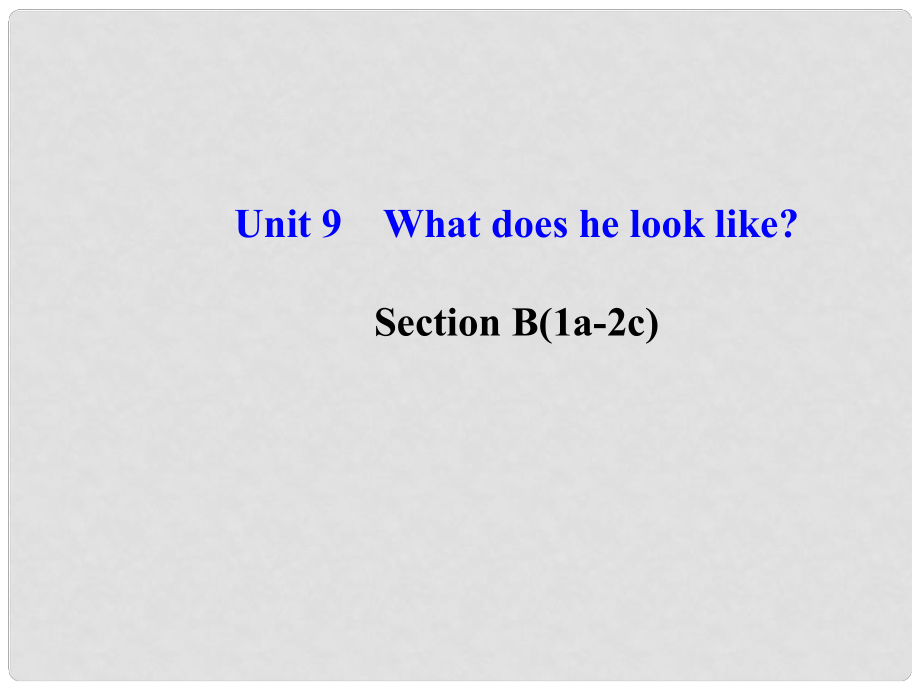《七年級(jí)英語下冊(cè) Unit 9 What does he look like Section B(1a2c)課件 (新版)人教新目標(biāo)版》由會(huì)員分享�,可在線閱讀���,更多相關(guān)《七年級(jí)英語下冊(cè) Unit 9 What does he look like Section B(1a2c)課件 (新版)人教新目標(biāo)版(18頁珍藏版)》請(qǐng)?jiān)谘b配圖網(wǎng)上搜索。
1�、Unit 9What does he look like? Section B(1a-2c). 詞圖匹配詞圖匹配a long face, big eyes, a round face, a big nose答案答案: 1. a big nose2. a round face3. big eyes4. a long face. 句型展示句型展示1. 許多人看待事情的方式并不總是相同許多人看待事情的方式并不總是相同, 因此他們對(duì)同一個(gè)人因此他們對(duì)同一個(gè)人的描述可能不同。的描述可能不同����。Many people dont always see things waythey may describe t
2、he same person. 答案答案: the same; so; differently2. 他留著又長又直的褐色頭發(fā)他留著又長又直的褐色頭發(fā), 長著大眼睛��。長著大眼睛�。Helong straight brown hair and . 3. 最后最后, 真正的罪犯是一個(gè)又矮又胖真正的罪犯是一個(gè)又矮又胖, 年紀(jì)很大的人年紀(jì)很大的人, 他留著短他留著短而黑的頭發(fā)而黑的頭發(fā)! , the real criminala short and heavy old man, and short black hair! 答案答案: 2. has; big eyes 3. In the end; is;
3、he has1. Then Joe draws a picture of the criminal, and the police put it in newspapers and on television to find him. 然后然后, 喬畫出罪喬畫出罪犯的圖片犯的圖片, 并且警察把它登在報(bào)紙和電視上來找到他����。并且警察把它登在報(bào)紙和電視上來找到他?�!咀灾黝I(lǐng)悟自主領(lǐng)悟】put此處意為此處意為“把把放在放在; 擺擺; 擱擱; 安置安置”, 常用常用于下面結(jié)構(gòu)中于下面結(jié)構(gòu)中: (1)put+賓語賓語+介詞短語介詞短語���。例如�。例如: Please put the book on the de
4�、sk. 請(qǐng)把書放在書桌上。請(qǐng)把書放在書桌上�����。(2)put+賓語賓語+副詞副詞(短語短語)。例如�。例如: Lets put our books away. 讓我們把書收起來。讓我們把書收起來��?�!練w納拓展歸納拓展】與與put相關(guān)的常見詞組相關(guān)的常見詞組put on 穿上穿上(衣服衣服)put away 放好放好put up 舉起舉起; 張貼張貼put down 放下放下, 寫下寫下【活學(xué)活用活學(xué)活用】 讓我們把這幅畫放在桌上��。讓我們把這幅畫放在桌上���。Letsthe picture . 請(qǐng)放下你的手�。請(qǐng)放下你的手���。Please your hands. 答案答案: put; on the deskpu
5��、t down2. He wants to draw a good picture of each criminal, but this job is sometimes difficult. 他想要畫好每個(gè)罪犯的圖片他想要畫好每個(gè)罪犯的圖片, 但這項(xiàng)工作有時(shí)候難�����。但這項(xiàng)工作有時(shí)候難�����?!咀灾黝I(lǐng)悟自主領(lǐng)悟】each此處用作形容詞此處用作形容詞, 意為意為“每個(gè)每個(gè)”, 修飾修飾可數(shù)可數(shù)名詞單數(shù)名詞單數(shù)���。例如����。例如: Each boy has a new pen. 每個(gè)男孩有一支新每個(gè)男孩有一支新鋼筆����。鋼筆?�!居梅ū嫖鲇梅ū嫖觥縠ach的不同詞性的不同詞性作代詞作代詞意為意為“每個(gè)每個(gè), 各個(gè)各個(gè)”
6����、, 可單獨(dú)作主語可單獨(dú)作主語, 也可后也可后接接of短語短語, 作主語時(shí)作主語時(shí), 謂語動(dòng)詞用第三人稱單謂語動(dòng)詞用第三人稱單數(shù)數(shù); 作同位語時(shí)作同位語時(shí), 要放在主語的后面要放在主語的后面作副詞作副詞常放在動(dòng)詞之后或句末常放在動(dòng)詞之后或句末【活學(xué)活用活學(xué)活用】 每個(gè)學(xué)生都有自己的詞典。每個(gè)學(xué)生都有自己的詞典����。 has his own dictionary. Each of us(like)the singer. We each(want)to get the ball. 答案答案: Each studentlikeswant3. Another woman says, “He is tall
7、and thin, and he has curly blond hair. ”另一位女士說另一位女士說: “他又高又瘦他又高又瘦, 留著金黃色的卷發(fā)����。留著金黃色的卷發(fā)����?���!薄咀灾黝I(lǐng)悟自主領(lǐng)悟】(1)another作限定詞作限定詞, 后常接單數(shù)名詞或代詞后常接單數(shù)名詞或代詞one, 修飾限定名修飾限定名詞或代詞詞或代詞one, 表示表示“(三者或三者以上的三者或三者以上的)另一個(gè)另一個(gè)”。例如例如: Would you like another apple? 你想要另一個(gè)蘋果嗎你想要另一個(gè)蘋果嗎? No, thanks. Im full. 不不, 謝謝���。我飽了����。謝謝�����。我飽了�����。(2)another
8����、作代詞作代詞, 指代同類人或事物中的另一個(gè)指代同類人或事物中的另一個(gè), 可在句中作可在句中作主語或賓語。主語或賓語。例如例如: I dont like this one. Please show me another. 我不喜歡這一個(gè)��。請(qǐng)給我看另一個(gè)����。我不喜歡這一個(gè)�。請(qǐng)給我看另一個(gè)?�!居梅ū嫖鲇梅ū嫖觥縜nother與與the other的區(qū)別的區(qū)別【活學(xué)活用活學(xué)活用】 請(qǐng)?jiān)俳o我一張桌子��。請(qǐng)?jiān)俳o我一張桌子��。Please give me . 他有兩個(gè)孩子�。一個(gè)是杰克他有兩個(gè)孩子。一個(gè)是杰克, 另一個(gè)是湯姆��。另一個(gè)是湯姆���。He has two children. is Jack, is Tom.
9�、答案答案: another deskOne; the other. 用所給詞的適當(dāng)形式填空用所給詞的適當(dāng)形式填空1. Jay Chou is my favorite(sing). I like all his songs. 2. They talk about the new movie(different). 3. Alan likes painting. He wants to be an(art). 4. Toms uncle is a policeman. He thinks his job is(real)interesting. 5. We can work out the mat
10�、h problem in different(way). 答案答案: 1. singer2. differently3. artist4. really5. ways. 單項(xiàng)選擇單項(xiàng)選擇1. What does your friend look like? . A. He is thinB. She is a kind girlC. She likes music D. She has good-looking2. Each of the studentshis homework on time. A. doing B. to doC. doD. does3. Is Mrs. Brown short? . But her son is very tall. A. Yes, she is B. No, she isntC. No, she doesntD. Yes, she does4. Im busy now. Lets talk about itday. A. otherB. the otherC. othersD. another5. the end, the police caught(抓住抓住)the real criminal. A. At B. In C. OnD. By
 七年級(jí)英語下冊(cè) Unit 9 What does he look like Section B(1a2c)課件 (新版)人教新目標(biāo)版
七年級(jí)英語下冊(cè) Unit 9 What does he look like Section B(1a2c)課件 (新版)人教新目標(biāo)版

